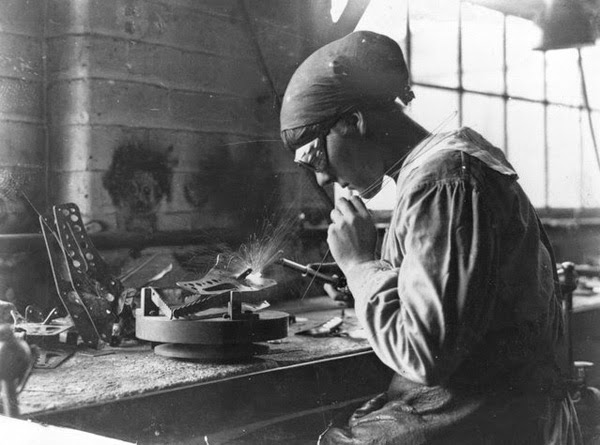World War One and the Changing Attitude to Women
World war one broke out across Europe in 1914 and both the Suffragists and the Suffragettes suspended their campaign to the right to vote.
The Suffragists worked hard to get young men to join the army and a large demonstration was held demanding that women be allowed to work in the munitions factory (BBC, 2014).
Women gained access to a wide range of vocations including bus conducting, postal workers and coal delivery. Many women surprised their male counterparts by succeeding in heavy manual work as well as skilled, dexterous work such as engineering (BBC, 2014).
Iconic image of 'Rosie the Riveter'
http://www.visualnews.com/2013/09/03/working-women-first-world-war/
Women working in a munitions factory during WW1
http://www.visualnews.com/2013/09/03/working-women-first-world-war/
Traditional family structure was completely changed by the First World War.
Many married women were forced into the workplace by the death of their husbands.
Other women were drafted into industries that had been depleted by military conscription.
Over the course of the war:
- 200,000 women took up jobs in governmental departments.
- 500,000 took up clerical positions in private offices.
- 250,000 worked on in agricultural positions.
- 700,000 women took up posts in the munitions industry, which was dangerous work.
- Many more women did hard heavy work, including ship building and furnace stoking. These types of jobs had excluded women prior to the war.
In July 1914, before the war broke out there were 3.2 million women in employment. This had risen to 5 million by January 1918.(BBC, 2014)
The war meant women had to take on a number of traditionally male roles. Their ability to do this led to a change in attitudes.
World War 1 caused the British suffrage movement to split:
- Emmeline Pankhurst (leader of the Women’s Social and Political Union) called for a temporary ceasefire in their campaign so the country could focus fully on the war effort.
- Sylvia Pankhurst and her Women’s Suffrage Federation were more radical and wanted the struggle to continue in spite of the situation.
When the war ended in November 1918 8.4 million women were granted the right to vote.
The Eligibility of Women Act was also passed in November 1918. This meant that some women could now be elected as members of Parliament.
World War 1 was undoubtedly the final catalyst for women to be given the vote. However, women would have to wait until 1928 to be granted the vote on equal terms with British men. This was brought by the Representation of the People Act, which stated all women over the age of 21 could vote (BBC, 2014)
There is no doubt that the war played an influential part in women gaining the right to vote but it was not the only key factor. Tireless campaigning by both parties of the suffrage movement, the NUWSS and WSPU played key roles in securing the right to vote, however that said, the women's effort in the war begs the question 'How could a country happily accept the help of its female population and yet still deny them the right to participate in its decision making process?'.


No comments:
Post a Comment